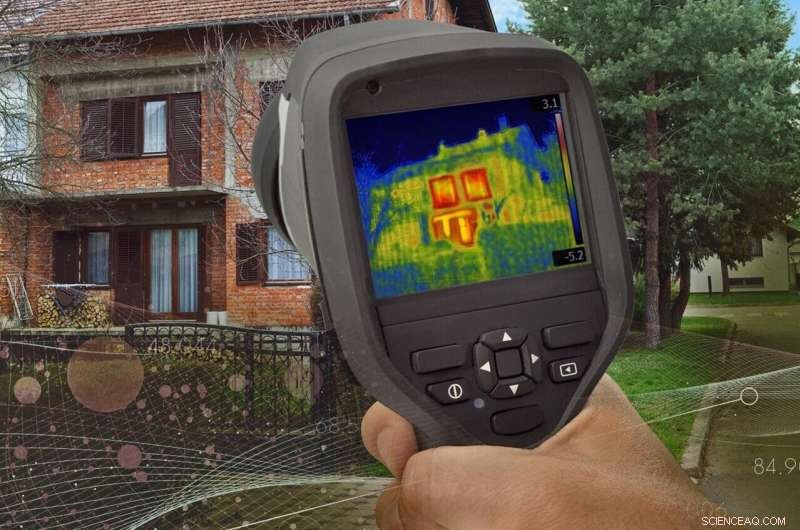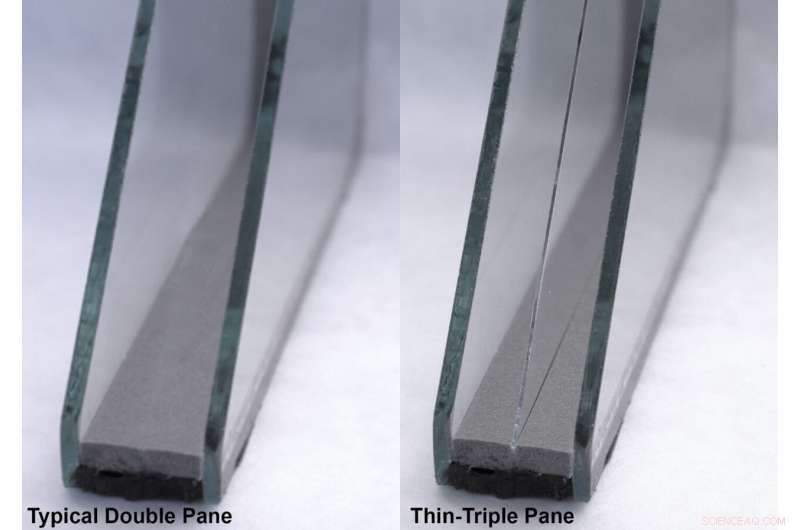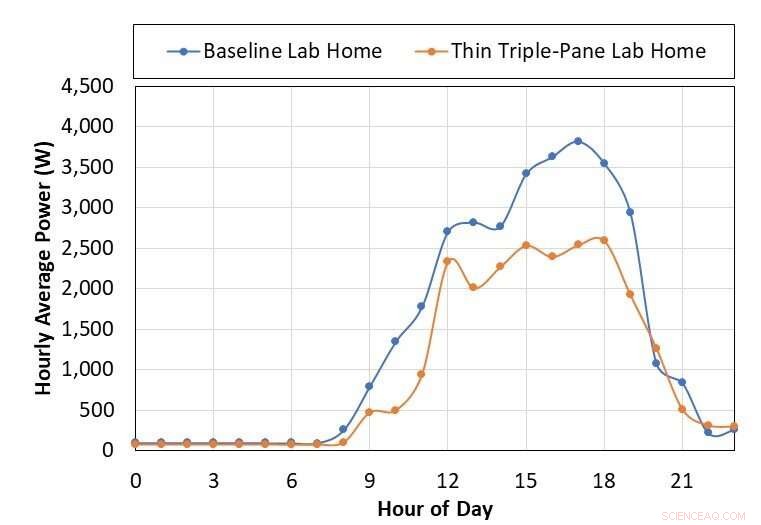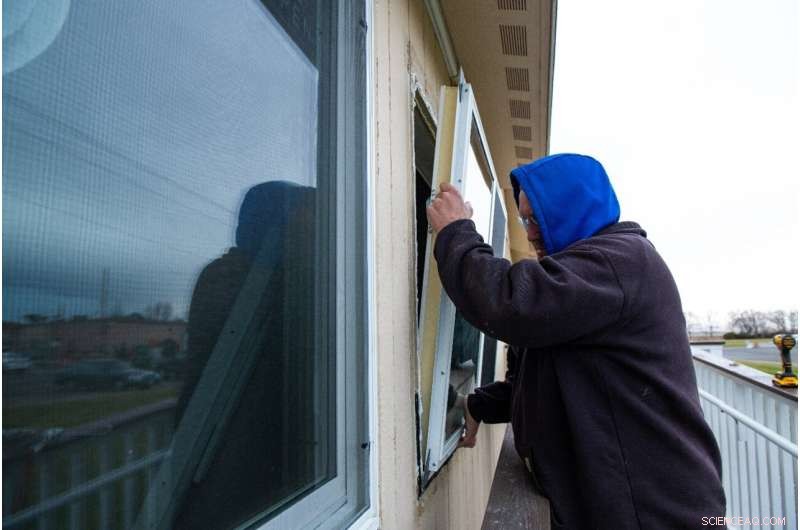
Wetenschap
Hoe driedubbele ramen voorkomen dat energie (en geld) uit het raam vliegt

Infrarood (IR) beeldvormingstechnologie (hier afgebeeld) is een van de instrumenten die worden gebruikt om warmteverlies door slecht geïsoleerde ramen te meten. Een reeks onderzoeken toont aan dat een nieuwe generatie driedubbele ramen kan helpen de energie-efficiëntie in huizen te verbeteren. Krediet:Timothy Holland | Pacific Northwest Nationaal Laboratorium
Het is tijd om over te stappen op driedubbele vensters. Dat is de boodschap van een reeks onderzoeken onder leiding van het Pacific Northwest National Laboratory van het Department of Energy in samenwerking met een coalitie van publieke en private partners.
"Lagere kosten, grotere beschikbaarheid en het streven om de CO2-uitstoot te verminderen, duwen ons naar een omslagpunt waar driedubbele beglazingen veel economisch zinvol worden", zegt Kate Cort, een onderzoekseconoom bij PNNL en programmamanager voor lopend veld validatiestudies van driedubbele vensters.
Het is geen geheim dat de ramen van een huis veel energie kunnen verspillen. Ze kunnen lucht lekken en zelfs de nieuwste modellen dubbele beglazing dragen aanzienlijk bij aan het energieverbruik en de kosten in een huis. Voor een nieuw huis maken ramen doorgaans ongeveer 8% van het buitenoppervlak uit, maar ze zijn verantwoordelijk voor de helft van het warmteverlies of de warmtewinst. Door dit passieve energieverlies leveren ramen een belangrijke bijdrage aan de kosten voor verwarming en koeling van woningen.
Ondertussen stapelt het bewijs voor de energie- en kostenbesparingen van driedubbele ramen zich al jaren langzaam op, sinds de eerste prototypes rond 1989 werden geïntroduceerd. Eerdere studies hebben aangetoond dat driedubbele ramen energiezuiniger zijn dan de industriestandaard dubbele ramen. paneelvariatie, maar de acceptatie op de markt verliep traag vanwege de kosten en beschikbaarheid.
Die nadelen staan op het punt te veranderen, zei Cort. Een nieuwe generatie dunne driedubbele ruiten is goedkoper en kan gemakkelijker achteraf worden ingebouwd in bestaande dubbele beglazing. Zoals hun naam al aangeeft, hebben driedubbele beglazingen drie glasplaten die een dubbeldekkersandwich vormen, die wordt gevuld met een inert gas, zoals krypton, dat voor extra isolerend vermogen zorgt. Deze ramen van de volgende generatie profiteren van de schaalvoordelen die worden geboden door dezelfde geavanceerde glasproductietechnologie die dunne maar duurzame tv- en computerschermen produceert.
In de afgelopen drie jaar hebben Cort en haar collega's systematisch de energiebesparingen en economische factoren geëvalueerd die bepalen hoe snel ze worden geaccepteerd door bouwers. Dit werk werd ondersteund door het DOE Building Technologies Office en de Bonneville Power Administration.
Nu beginnen de regelgevende instanties van de staat dit op te merken. Onlangs heeft de staat Michigan gegevens uit een PNNL-veldonderzoek van driedubbele ramen gebruikt om ze op te nemen in de technische handleiding van de staat met goedgekeurde energiebesparende maatregelen die in aanmerking komen voor stimuleringsmaatregelen en kortingen van nutsbedrijven.
Nieuwe energienormen creëren urgentie
Een ander recent onderzoek onder leiding van Cort, PNNL-collega Edward Louie en Robert Hart van het Lawrence Berkeley National Laboratory toonde aan dat voor de nieuwbouw van woningen, driedubbele beglazingen bouwers kunnen helpen om op een betaalbare manier te voldoen aan strengere 2021-energiecodes voor nieuwe huizen. Hun studie, gepubliceerd in het maartnummer van ASHRAE Journal toonde aan dat wanneer een huisbouwer de ramen van een nieuw huis opwaardeert van dubbele naar driedubbele beglazing, de energie-efficiëntieprestaties van de ramen met 40% of meer kunnen verbeteren. Deze toegevoegde prestatie verhoogt de totale isolatiewaarde van de hele buitenkant van het huis, vaak de gebouwschil genoemd.
"Ons onderzoek toonde aan dat het verhogen van de energie-efficiëntie van ramen bouwers meer flexibiliteit biedt in het ontwerp en de mogelijkheid om compromissen te sluiten met andere componenten van de omhulling, zoals buitenmuurisolatie, terwijl ze voldoen aan de code", aldus Cort. Het algemene effect is dat bouwers meer opties en een betere zekerheid krijgen dat ze voldoen aan de bouwvoorschriften, terwijl het comfort voor huiseigenaren wordt verbeterd.

Thin triple-pane windows (right) have three panes of glass filled with an inert gas, krypton, and coated with a low-emission film to enhance energy efficiency. Credit:Lawrence Berkeley National Laboratory
What's the hold up for triple-pane windows?
Builders play a key role in the adoption of new home building technologies, said Cort. In 2020, she and her colleagues interviewed 29 home builders who have participated in the DOE Zero Energy Ready Home program. They asked builders to explain their decision-making process for window selection during the 2018 to 2019 building season. Forty-one percent of these builders used triple‐pane windows in all their new homes and another 28% in most or some of their homes. For those who didn't use triple-pane windows, the biggest factor was cost.
"The price differential between double-pane and triple-pane windows has been a pain-point for builders," Cort noted. But she added that the increased incremental material cost of triple-pane windows is now about $700 to $2,400 for a 2,400-square-foot wood-framed home. This is about the same cost as adding an extra inch of rigid wall insulation to the same home.
Some builders also stated that the indirect cost of custom installation for triple-pane windows, which can be 25% to 50% heavier than similar sized double‐pane windows, also weighed into their choice.
"Most builders aren't familiar with the newer thinner, lighter triple-pane technology," said Cort. But the survey showed most would be willing to try them if the cost and availability made it practical for them.

Thin triple-pane windows greatly reduced the power usage by the air-conditioning system in the hottest part of the day, compared with standard double-pane windows. The direct comparison was made in identical custom Lab Homes on the PNNL campus in summer 2020. Credit:Katherine Cort | Pacific Northwest National Laboratory
Some of the builders Cort's team interviewed noted that consumers like the comfort and quiet of triple-pane windows. A recent study confirmed that the installation of thin triple-panes reduced the sound infiltration by an average of 8-10 decibels when compared to the home with double-pane metal-frame windows, which roughly equates to reducing the perceived noise level by half.
"When someone comes into the house and you shut the door, it's like getting into a Mercedes or BMW," said a Seattle builder. "It's so solid and quiet. We are building homes next to Boeing Field airport in Seattle. Planes are flying right overhead so close you can clearly see them from the houses, and it is so quiet inside you can't hear them."
Demonstration projects lead the way
When there are new approaches to home building, said Cort, builders need assurances that materials will be available when needed, hold up under use, and deliver on promised improvements.
To help meet those expectations, PNNL has joined forces with DOE, Lawrence Berkley National Laboratory, and the Northwest Energy Efficiency Alliance to launch the Partnership for Advanced Window Solutions. With support from DOE, this public-private partnership is working with builders, utilities, and manufacturers to both drive demand and scale up production of cost-effective "drop-in" thin triple-pane window designs and other high-performance window solutions.

Installers insert thin triple-pane windows at a PNNL Lab Home, custom model homes on the PNNL campus built to conduct energy efficiency research. Credit:Andrea Starr | Pacific Northwest National Laboratory
The PNNL team recently compared the energy efficiency performance of these windows in its Lab Homes, a pair of identical manufactured homes used to study energy efficiency. During the winter heating season of 2019 and the summer cooling season of 2020, researchers recorded energy usage and temperatures throughout the homes. During the two 10-week evaluation periods, the windows saved an average of 12% on heating and 28% on cooling for the 1,500-square-foot structures. In addition, the home with the triple-pane windows reduced outdoor noise and maintained much more comfortable and even temperatures throughout the home during both summer and winter testing periods.
The research team is now field testing the windows in 10 locations nationwide, from manufactured homes in Pasco, Wash., to a net-zero apartment complex in Rotterdam, N.Y. In these field demonstration projects, the incremental cost over standard ENERGY STAR windows was $6 per square foot or less, said Cort. Within the last year, multiple versions of the thin-glass triple-pane units have been developed, certified by the National Fenestration Rating Council, and have become available to builders.
"At this point, it's a matter of increasing awareness among manufacturers, builders, utility programs, and consumers," said Cort. "It's time to look at windows, not just through them."
 De bouwhausse in Florida bedreigt een lagune die rijk is aan wilde dieren
De bouwhausse in Florida bedreigt een lagune die rijk is aan wilde dieren Orkaan Grace laat minstens 8 doden achter in Mexico
Orkaan Grace laat minstens 8 doden achter in Mexico NASA vindt tropische storm Irondros zware regenval verplaatst
NASA vindt tropische storm Irondros zware regenval verplaatst Hoe de term Antropoceen van geowetenschap naar hashtags sprong
Hoe de term Antropoceen van geowetenschap naar hashtags sprong Niet meer Ibiza? 56 tot 65% van het strand op de Balearen zal permanent verloren gaan als gevolg van de klimaatcrisis
Niet meer Ibiza? 56 tot 65% van het strand op de Balearen zal permanent verloren gaan als gevolg van de klimaatcrisis
Hoofdlijnen
- Onderzoeker rapporteert belangrijke componenten van antivirale verdediging van honingbijen
- Tsunami onthult menselijke geluidsoverlast in Hawaiiaanse wateren
- Stamcelvaccins: de nieuwe grens in kanker-therapie?
- Forensische wetenschapsprojecten voor middelbare scholieren
- De locatie van Cilia en Flagella
- Fossielen van zaagvissen suggereren dat tanden waarschijnlijk zijn geëvolueerd uit schubben in oude vissen
- E. Coli kweken in een petrischaal
- De rol van GTE in DNA-extractie
- Ziek dolfijnkalf verbetert met sondemelk, helpende handen
- Silicon Valley ziet Afrika als nieuwe technologische grens

- OpenAI Five wint een best-of-three, kijkt naar International volgende

- Een robot helemaal opnieuw printen:het combineren van vloeistoffen en vaste stoffen kan leiden tot snellere, flexibelere 3D-creaties

- Europa wil internet hervormen met nieuwe copyrightregels

- Virus kan $ 5 miljard aan verliezen voor luchtvaartmaatschappijen betekenen:VN-agentschap

 Interdisciplinaire samenwerking levert de moeilijkste, dunste coatings tot nu toe ontdekt
Interdisciplinaire samenwerking levert de moeilijkste, dunste coatings tot nu toe ontdekt Enquête identificeert een groeiende behoefte aan het inhuren van data-analisten voor banen bij de overheid
Enquête identificeert een groeiende behoefte aan het inhuren van data-analisten voor banen bij de overheid Enquête onderzoekt het gebruik van kooldioxide bij oliewinning en ondergrondse opslag
Enquête onderzoekt het gebruik van kooldioxide bij oliewinning en ondergrondse opslag Hittegolftemperaturen in India passeren 50 Celsius
Hittegolftemperaturen in India passeren 50 Celsius Ecologen luiden alarm over plasticvervuiling
Ecologen luiden alarm over plasticvervuiling Subglaciale valleien en bergketens ontdekt in de buurt van Zuidpool
Subglaciale valleien en bergketens ontdekt in de buurt van Zuidpool Hoe fosfor uit de kou kwam
Hoe fosfor uit de kou kwam Nieuw materiaal om de grenzen van op silicium gebaseerde elektronica te verleggen
Nieuw materiaal om de grenzen van op silicium gebaseerde elektronica te verleggen
- Elektronica
- Biologie
- Zonsverduistering
- Wiskunde
- French | Italian | Spanish | Portuguese | Swedish | German | Dutch | Danish | Norway |

-
Wetenschap © https://nl.scienceaq.com

